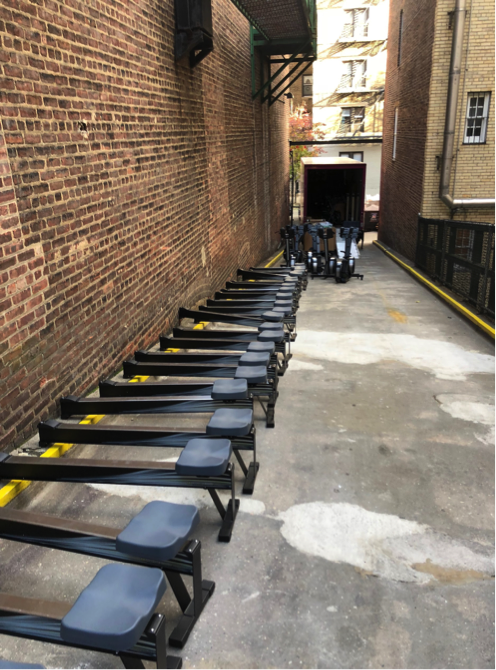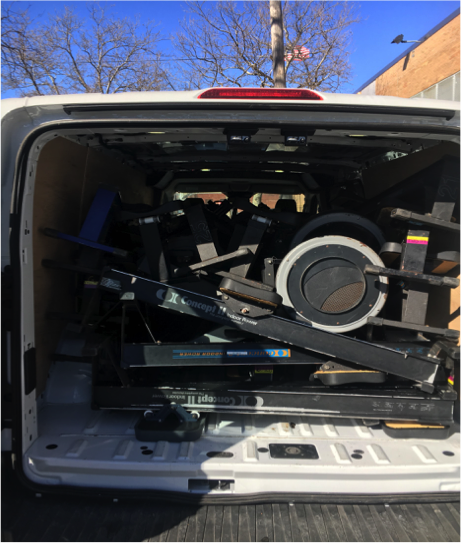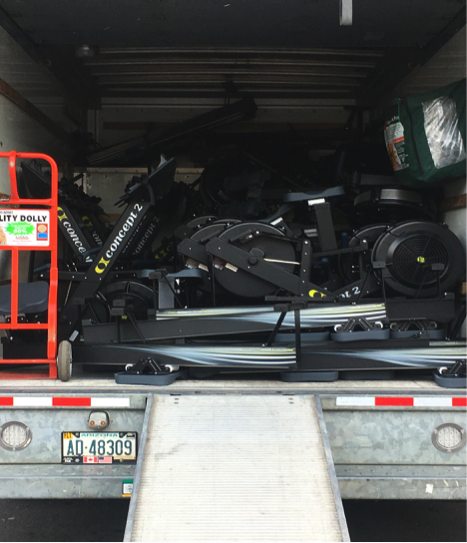By Matt Logue, Director of Boathouse Operations
One of the best parts of working at Row New York is bringing rowing TO the many communities of New York City. With programs like our Middle School Indoor program, Youth Justice, Freedom Rows and countless other indoor programs, we get to introduce our sport to all 5-boroughs and hundreds of individuals each year.
Rewarding does not fully capture the true impact of these programs. The logistics, well, those can get a little tricky. Taking rowing from the boathouse to the school, community center, rehab hospital, park, etc. requires patience, teamwork, some packing creativity and more patience. If you are considering a mobile rowing operation in New York City, it’s best to have options.
Here are 3 that we have used at Row New York:
The Passenger Van, sans seats: In our RNY fleet, we have three vans (12 to 15 passenger) that we use to transport athletes to programming and regattas. These vans are an ideal size to transport anywhere from 5 – 25 ergs AFTER the seats are removed. Given that the seat’s first function is to safely secure passengers during transport, they are often reluctant to come out of the van. This is where the first round of patience is required. Working with a team is also recommended with this option as it will increase the efficiency and reduce the risk of back injury while wrestling with the seats and during the load/unload process. Given that the primary purpose of these vans is to transport students for programming, they also need to be back to the boathouse (with seats) by the early afternoon. Since NYC traffic is always predictable, the added variable of traffic can add stress for the driver. The best way to eliminate this stress is to…
…rent a Cargo Van: Same size as the passenger with the added benefit of the seats already being removed! Just load and go! If you get tied up in traffic (and you will!), no worries! The cargo van is not needed to transport students so you will have plenty of time to sit in gridlock with your favorite podcast. The additional cost of renting for a cargo van for a day is well worth the peace of mind for the driver and ensures all programming can continue without interference. Depending on the number of ergs you need to move and your comfort level with driving, medium sized box trucks are also an option. U-Hauls are ok, but there is a commercial box truck rental place nearby, they usually have several sizes that include perfectly flat interiors (no wheel wells!).
Movers: The third, and my personal favorite, way to transport ergs in NYC is to work with a moving company. I highly recommend this when transporting more than 30 ergs at a time. The size truck you would need to accommodate more than 30 ergs is larger than most non-CDL drivers are comfortable with in NYC and making multiple trips can eat up a lot of time, energy and sanity.
The tie that binds…
One unifying factor that all 3 of these options share, is that creativity must be used to safely load and secure the ergs. The most effective way we have found (after LOTS of trial and error) is the horizontal-alternating-flywheel-with-the-upside-down-seat system. Here is how it works:
Step 1: Load the first flywheel so that the side of the fan is up against the back of the driver’s seat. The front of the erg should be facing the driver’s side of the van with the feet flat on the floor.
Step 2: Load the second facing the opposite direction so that the ergs overlap and are therefore able to get very close to one another. The foot stretchers actually fit under the diagonal housing for the chain (you may have to lower the adjustable feet for a better fit).
Step 3: Continue alternating ergs in this pattern until all 20 are in the van. There will be some minor shuffling and adjusting along the way.
Step 4: Once all the flywheels are loaded, you can being loading slides on top of the ergs in the channel formed by the alternating flywheels. This must be done carefully to ensure the monitors are not damaged. It is also best if the slides are placed seats down. You can stagger them so that they will not move/slide while driving.
Step 5: Not all 20 slides will fit in the channel so you can stack the rest at the back of the van (there should be room between the flywheels and the door) with the seats down and alternate the direction of the feet. The seats can be moved to fit under the slide next to them in an interlocking pattern to prevent sliding during transit. This method will work serval levels high. Additional slides can also be used on the sides to fill gaps between the flywheels and the wall of the van. This gap-filling method also reduces the likelihood of the ergs shifting in transit.
Depending on the overall number of ergs and the model of the vehicle you use, there are countless ways to configure the ergs within. The two key factors of any loading/transport job are safety and security. Safety is the number one priority: your safety and the safety of those around you on the road are paramount. The security of your load is a very close second. The last thing we want are the ergs getting damaged in transit or moving around to the point of distraction for the driver. Keeping these factors and the forefront of your mind when loading will help make the entire transportation process more efficient and leave you with more energy to provide great programming!
Coming in Spring 2018, Trailering Boats Through Manhattan: Escape from New York






